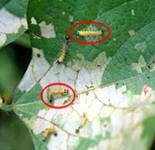| Bihar hairy caterpillar: Spilosoma obliqua |
Symptoms of damage
- Young larvae feed gregariously on chlorophyll mostly on the under surface of the leaves, due to which the leaves look like brownish-yellow in colour.
- In later stages the larvae eat the leaves from the margin.
- The leaves of the plant give an appearance of net or web
|
 |
| Larval scrabbing |
|
Identification of the pest
- Eggs: Laid in cluster on the under side of leaves.
- Larva: Covered with long yellowish to black hairs
- Adult: Medium sized brown moth with a red abdomen
|
Management
- Deep summer ploughing.
- Avoid pre monsoon sowing.
- Use optimum seed rate.
- Adequate plant spacing should be provided
- Intercrop soybean either with (early maturing) pigeon pea variety or maize or sorghum in the sequence of 4:2 should be practiced.
- Collect & destroy infested plant parts, egg masses and young larvae.
- Field Sanitation: Remove the infested plant parts at least once in 10 days and bury them in compost pit to monitor and reduce the population.
- Light Trap: Install one light trap (200W mercury vapour lamp) per hectare to catch the adults of some nocturnal pests such as hairy caterpillar (positively phototropic).
- Apply chlorpyriphos 20 EC @ 1.5 lit/ha or trizophos 40 EC @ 0.8 Lit/ha or quinalphos 25 EC @ 1.5 lit/ha.
- Dust Chlorpyriphos 1.5% DP quinalphos 1.5% @ 25kg/ha when the population is likely to reach 10/m row length (ETL). Repeat it as needed.
|

